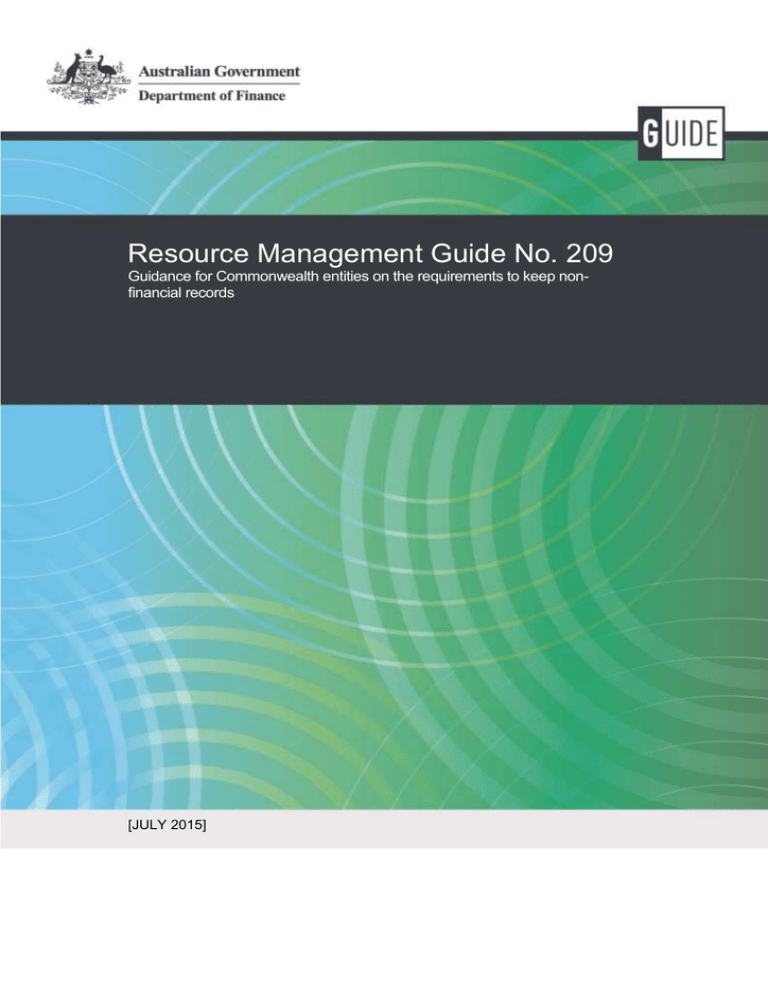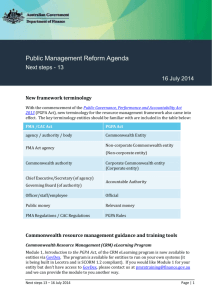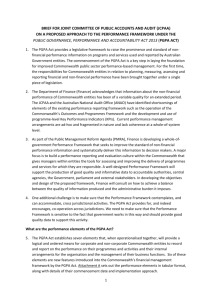RMG-209 Guidance for Commonwealth entities on the requirements
advertisement

Resource Management Guide No. 209 Guidance for Commonwealth entities on the requirements to keep nonfinancial records [JULY 2015] © Commonwealth of Australia 2015 ISBN: 978-1-925205-35-0 With the exception of the Commonwealth Coat of Arms and where otherwise noted, all material presented in this document is provided under a Creative Commons Attribution 3.0 Australia (http://creativecommons.org/licenses/by/3.0/au) licence. The details of the relevant licence conditions are available on the Creative Commons website (accessible using the links provided) as is the full legal code for the CC BY 3 AU licence. Use of the Coat of Arms The terms under which the Coat of Arms can be used are detailed on the following website: www.itsanhonour.gov.au/coat-arms. Contact us Questions or comments about this guide should be directed to: Public Management Reform Agenda Department of Finance John Gorton Building King Edward Terrace Parkes ACT 2600 Email: pmra@finance.gov.au Internet: www.pmra.finance.gov.au This guide contains material that has been prepared to assist Commonwealth entities and companies to apply the principles and requirements of the Public Governance, Performance and Accountability Act 2013 and associated rules, and any applicable policies. In this guide the: mandatory principles or requirements are set out as things entities and officials ‘must’ do; and actions, or practices, that entities and officials are expected to take into account to give effect to those principles and/or requirements are set out as things entities and officials ‘should consider’ doing. Audience This guide is relevant to officials of Commonwealth entities, both corporate and non-corporate. Key points This guide has been issued to assist officers meet their non-financial record keeping requirements under the Public Governance, Performance and Accountability Act 2013 (PGPA Act). Section 37 of the PGPA Act sets out the requirement for Commonwealth entities to keep records that properly document and report the entity’s non-financial performance. Section 38 of the PGPA Act sets out the requirement for Commonwealth entities to measure and assess its performance in achieving its objectives and purposes. The capacity of an entity to meet this requirement is directly reliant on the entity keeping accurate and complete records. A Commonwealth Performance Framework has been established as a key element of the PGPA Act. This Framework, which took effect from the 2015-16 reporting year, includes rules and guidance materials for entities to measure and assess its performance. This guidance has been written to provide information on: o Part 1 – Legislative obligations under the Archives Act; o Part 2 – The importance of good recordkeeping; o Part 3 – Legislative obligations under the PGPA Act; and o Part 4 – Further resources. Part 1 Legislative obligations under the Archives Act Under the Archives Act 1983, it is a legislative requirement for all Commonwealth entities to keep records. What is a record? A record is defined by the Archives Act 1983 as: “a document, or an object, in any form (including any electronic form) that is, or has been, kept by reason of: (a) any information or matter that it contains or that can be obtained from it; or (b) its connection with any event, person, circumstance or thing.”1 Records provide evidence of a Commonwealth entity’s business. All information created, sent and received in the course of business is potentially a record. A record can be a range of different things: a map, written report, email, film or sound recording. The format of the record created does not matter. What is important is that evidence of an entity’s activities is recorded in a way that supports business needs. To do this, records need to: 1 be complete, accurate and reliable; reflect the purpose they were created for; Archives Act 1983, Part I, Section 3, Preliminary. Resource Management Guide No. 209 Records about performance of entities | 1 be detailed enough to suit the circumstances and be understandable by others; and be created close to the event to ensure they are accurate and reliable. Creation and management of records Once created, records should be managed in a designated system that supports their use, tracking and understanding over time. This includes capturing a document’s metadata – that is: who created it; when was it created; why was it created; what is it about; what changes were made to the document over time; and what are its technical characteristics. Records that are easy to find and use have a significant impact on the efficiency of an entity. The appropriate area within the entity can be contacted for specific advice on the creation and management of records, and for details on the policies and procedures which support how this is carried out within the entity. Retention and disposal of records The Archives Act 1983 provides that, with some exceptions where other legislation applies, it is unlawful to destroy records without authorisation from the National Archives of Australia (Archives). Section 24 of the Archives Act provides the power for the Archives to authorise the disposal of records. The term ‘disposal’ includes destruction, alteration or transfer of records to the Archives. Authorisation for disposal is generally provided through a records authority. The Archives issues two types of Record Authorities to enable entities to retain records for appropriate periods before destruction or transfer to the Archives. They are: i. agency-specific records authorities covering the records created in the course of an entity’s core business or as part of the business of several entities; and ii. general records authorities covering administrative records created by various entities. The Archives Act 1983 also provides for the destruction of records in accordance with a normal administrative practice (NAP). A NAP makes it easier for an entity to dispose of short term, low value records. Records can be routinely destroyed using a NAP if they do not provide evidence of an entity’s business and do not form part of its corporate records. A NAP should be documented in your entity's policies and procedures. The Archives has range of resources available on their website to help Commonwealth entities meet their records management obligations. Products available include guidelines, checklists, online and face-to-face training programmes. Part 2 –The importance of good recordkeeping Recordkeeping is a key component of an entity’s corporate governance and is critical to its accountability and performance2 by: providing evidence and information about the Australian Government and its activities; providing specific information about the business and operations of Commonwealth entities; supporting sound decision-making and protects entities from risk; Recordkeeping in Large Commonwealth Organisations, Auditor-General Audit Report No.7 of 2003-04, Australian National Audit Office, Page 11. 2 Resource Management Guide No. 209 Records about performance of entities | 2 enabling entities to meet their responsibilities for open government; enabling information to be re-used, which creates efficiencies and maximises the use of scarce resources; helping to build better business systems; and supporting long-term accountability and sustainability. The APS Values and Code of Conduct, promoted by the Australian Public Service Commissioner, reinforce the requirement for informed and timely recordkeeping through a focus on being accountable and acting with care and diligence, and in compliance with all applicable Australian laws.3 The PGPA Act extends this obligation by conferring on the accountable authority of all corporate and non-corporate entities various responsibilities to promote high standards of accountability and performance, which includes the requirement for recordkeeping. Recordkeeping supports accountability and performance reporting. Part 3 – Legislative obligations under the PGPA Act The PGPA Act creates a specific obligation on entities to report on non-financial performance information. The PGPA Act elevates the obligation on Commonwealth entities to report on their non-financial performance. Non-financial performance information comprises quantitative and qualitative data on the policies pursued by an entity and its business operations. It refers to information that falls outside the scope of mainstream financial statements. The key provisions in the PGPA Act relating to non-financial recordkeeping are Sections 37(1) and 38(1): 37 Records about performance of Commonwealth entities (1) The accountable authority of a Commonwealth entity must cause records to be kept that properly record and explain the entity’s performance in achieving its purposes. (2) The accountable authority must ensure that the records are kept in a way that: (a) complies with any requirements prescribed by the rules; and (b) enables the preparation of the annual performance statements required by section 39. (3) The responsible Minister and the Finance Minister are entitled to full and free access to the records kept under this section. However, those Ministers’ access is subject to any Commonwealth law that prohibits disclosure of particular information. 38 Measuring and assessing performance of Commonwealth entities (1) The accountable authority of a Commonwealth entity must measure and assess the performance of the entity in achieving its purposes. The APS Values are set out in section 10 of the Public Service Act 1999 and the Code of Conduct is set out in section 13 of the Public Service Act 1999. 3 Resource Management Guide No. 209 Records about performance of entities | 3 (2) The measurement and assessment must comply with any requirements prescribed by the rules. Sections 37(1) and 38(1) both refer to the ‘purposes’ of a Commonwealth entity, where purposes refer to its objectives, functions or role. OBJECTIVES: Refers to the intended or desired results that are to be attained or accomplished, often prescribed through legislative or statutory requirements. FUNCTIONS: Refers to the actions or activities of the entity undertaken to produce a result. ROLE: Refers to how an entity operates in relation to its functions, principally in relation to its capacity, position, responsibilities and duties. Detailed guidance materials have been developed to assist Commonwealth entities with their planning, evaluating and reporting activities, with a particular focus on strengthening the quality of non-financial performance information. Stakeholders should consider accessing the following guides: RMG-130 Overview of the enhanced Commonwealth performance framework; RMG-131 Developing good performance information; and RMG-132 Corporate plan for Commonwealth entities. Part 4 – Further resources Further information and guidance related to resource management is available from finance.gov.au/resource-management/. Key tools on the site include: PGPA legislation & rules – links to the PGPA Act, and the rules and instruments made under it; Consolidated guidance – a complete index of all resource management guidance; Glossary – common resource management terms; and Support tools – introductory resources such as training and eLearning modules, and information on the Public Management Reform Agenda. Records Management The National Archives’ Agency Service Centre can be contacted via: Web: http://www.naa.gov.au/records-management/help/ Telephone: 02 6212-3610 Email: recordkeeping@naa.gov.au For information on the Archives products and services go to http://www.naa.gov.au/recordsmanagement/agency/index.aspx Resource Management Guide No. 209 Records about performance of entities | 4






